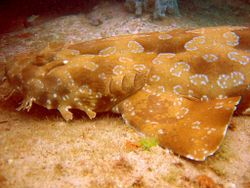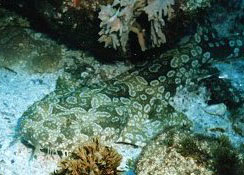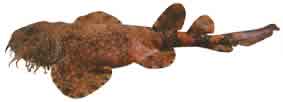Two New Wobbegongs Discovered
Posted by: Loren Coleman on February 14th, 2008

Known as carpet sharks to most of the rest of the world, two new species of wobbegongs, as they are called in Oz, have been found in Western Australian waters.

WA Department of Fisheries shark researcher Justin Chidlow said there were now eight known wobbegong shark species in Australia.
The new floral banded wobbegong has been spotted between Geraldton and Augusta and the new dwarf spotted wobbegong was found in shark fishery catches between Green Head and Mandurah, Mr Chidlow said.
Wobbegongs, which are often sold in fish shops under the name of carpet shark, are probably the most common shark species seen by divers.
“It’s amazing to think that the new species have been present off our coast, but that it’s only now that they have been formally identified as separate and been added to the list of known wobbegong species,” he said.
“Wobbegongs were not as sleek looking as some of the better-known sharks and the new species helped reinforce the importance of the continental shelf off WA as an area where a large range of wobbegong species could be encountered.”
The colour of the floral banded species is mainly dark brown with yellowish blotches on the upper surface and white on the underbelly, whereas the adult of the dwarf spotted wobbegong was a lighter yellowish brown with large white blotches on top and creamy coloured underneath.
Source: “Two new shark species found,” The Sydney Morning Herald, February 14, 2008.

Photos above are of wobbegongs, but not of the two new species, which are unavailable to date.
About Loren Coleman
Loren Coleman is one of the world’s leading cryptozoologists, some say “the” leading living cryptozoologist. Certainly, he is acknowledged as the current living American researcher and writer who has most popularized cryptozoology in the late 20th and early 21st centuries.
Starting his fieldwork and investigations in 1960, after traveling and trekking extensively in pursuit of cryptozoological mysteries, Coleman began writing to share his experiences in 1969. An honorary member of Ivan T. Sanderson’s Society for the Investigation of the Unexplained in the 1970s, Coleman has been bestowed with similar honorary memberships of the North Idaho College Cryptozoology Club in 1983, and in subsequent years, that of the British Columbia Scientific Cryptozoology Club, CryptoSafari International, and other international organizations. He was also a Life Member and Benefactor of the International Society of Cryptozoology (now-defunct).
Loren Coleman’s daily blog, as a member of the Cryptomundo Team, served as an ongoing avenue of communication for the ever-growing body of cryptozoo news from 2005 through 2013. He returned as an infrequent contributor beginning Halloween week of 2015.
Coleman is the founder in 2003, and current director of the International Cryptozoology Museum in Portland, Maine.










Great pictures.They blend in with their surroundings; no wander they were not discovered until now.
How many shark species await discovery? another 100, 200 or you name the figure?
I have a lot of hope for new shark discoveries in the future for a few reasons. First, sharks are an extremely diverse group, occupying a dizzying array of niches and coming in a wide range of sizes. Second, they are found all over the world, even in areas where you wouldn’t expect to find them, such as the Greenland shark lurking under the arctic ice, or deep sea sharks. Third, other major discoveries of large species very important to cryptozoology have been made in modern times, such as the discovery of the Megamouth shark. (found after it was pulled up with an anchor that it had tried to swallow.) And last of all, many species of shark are extremely elusive, being secretive, hard to find, and rarely seen. Scientists know very little about a large number of known shark species and sharks in general remain quite mysterious, so it is not so far fetched to me to think that there are unknown varieties successfully avoiding detection.
In my opinion, the chances of new large shark discoveries remain high. I especially think that we will possibly have some good finds with highly mobile or migratory deep, open water pelagic sharks (meaning they inhabit open water zones), and with bottom dwelling benthic sharks. Bottom dwelling sharks, as you can see with these beautiful wobbegongs, can have quite elaborate camouflage or even cover themselves with silt on the bottom, making them especially difficult to find. At the rate many shark species are being wiped out by mankind, I for one am thrilled to see new discoveries like this.